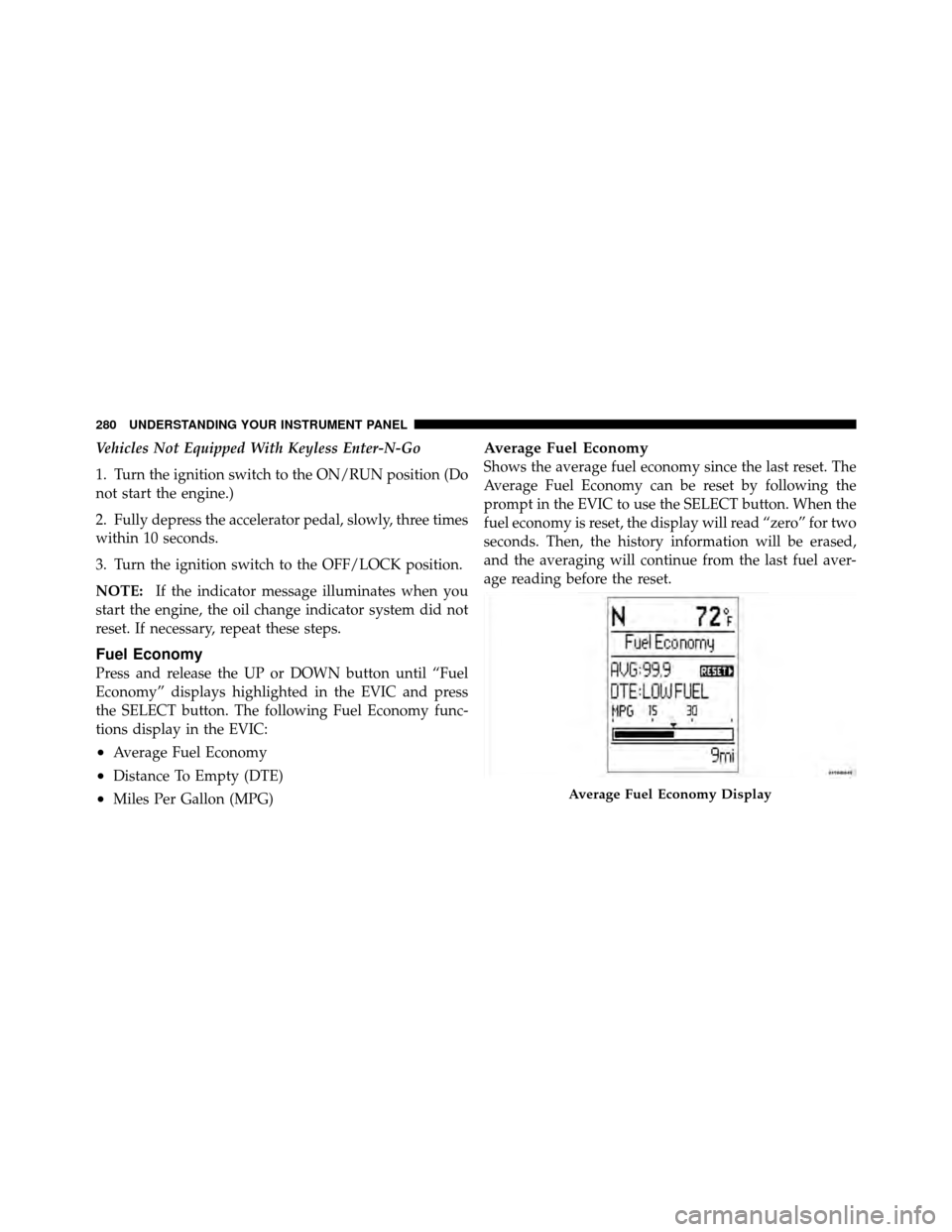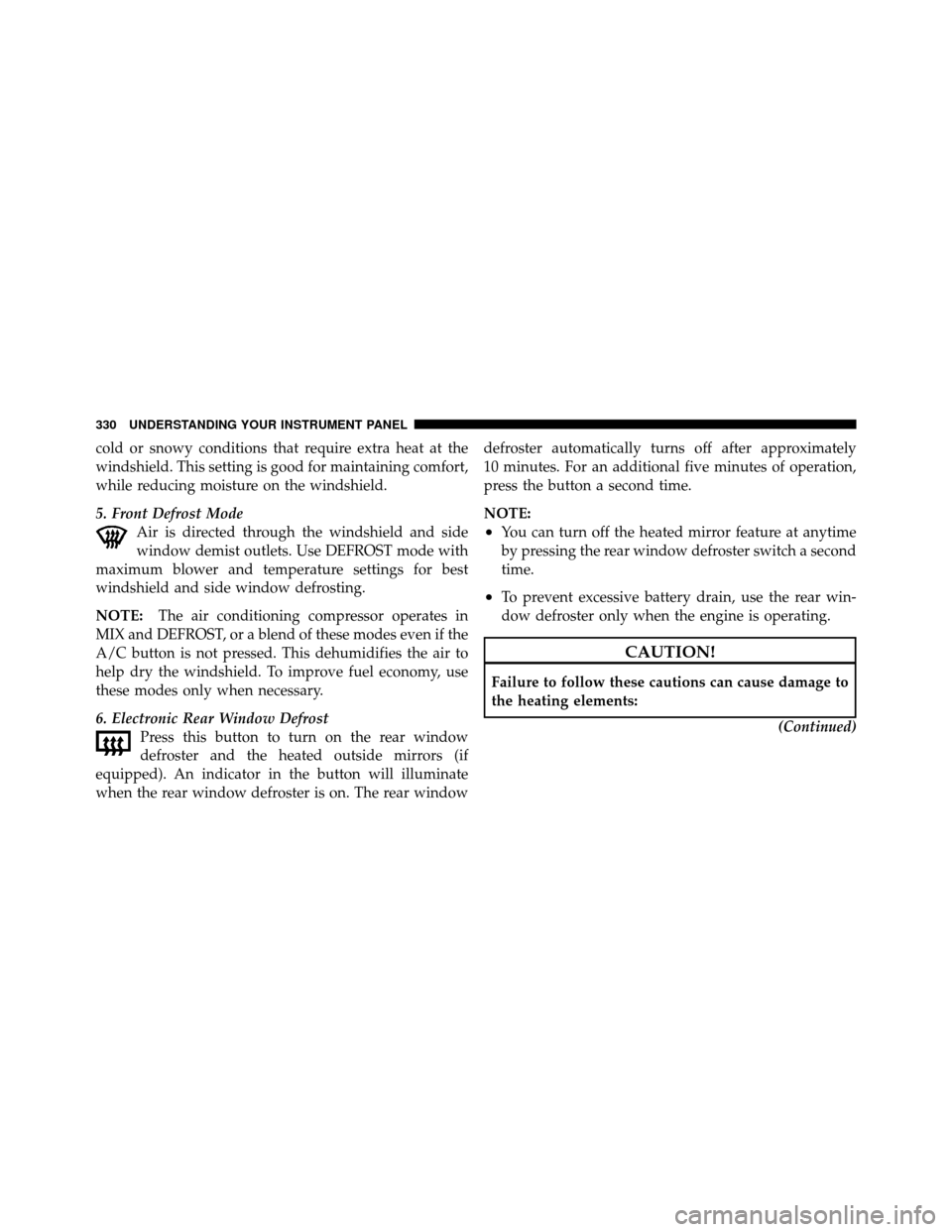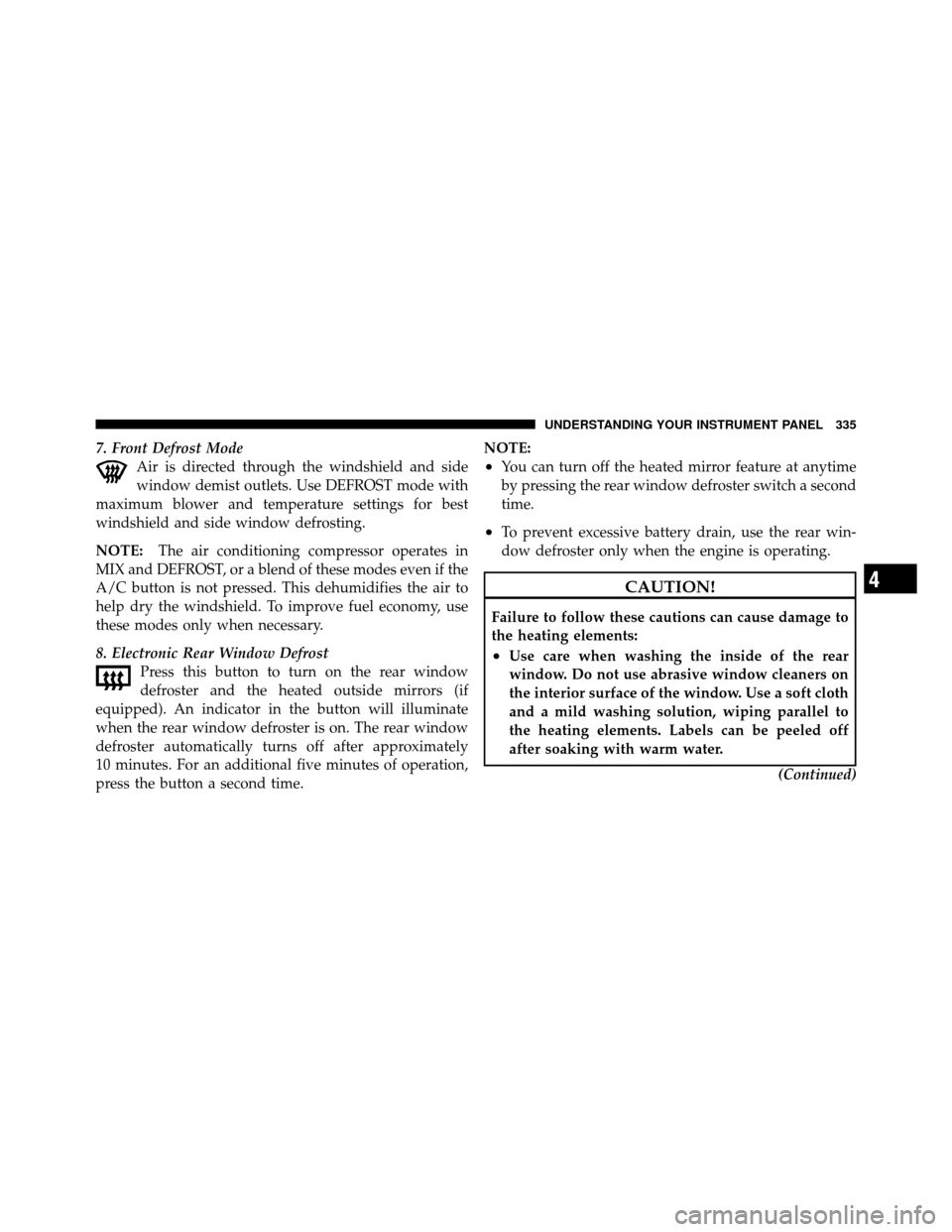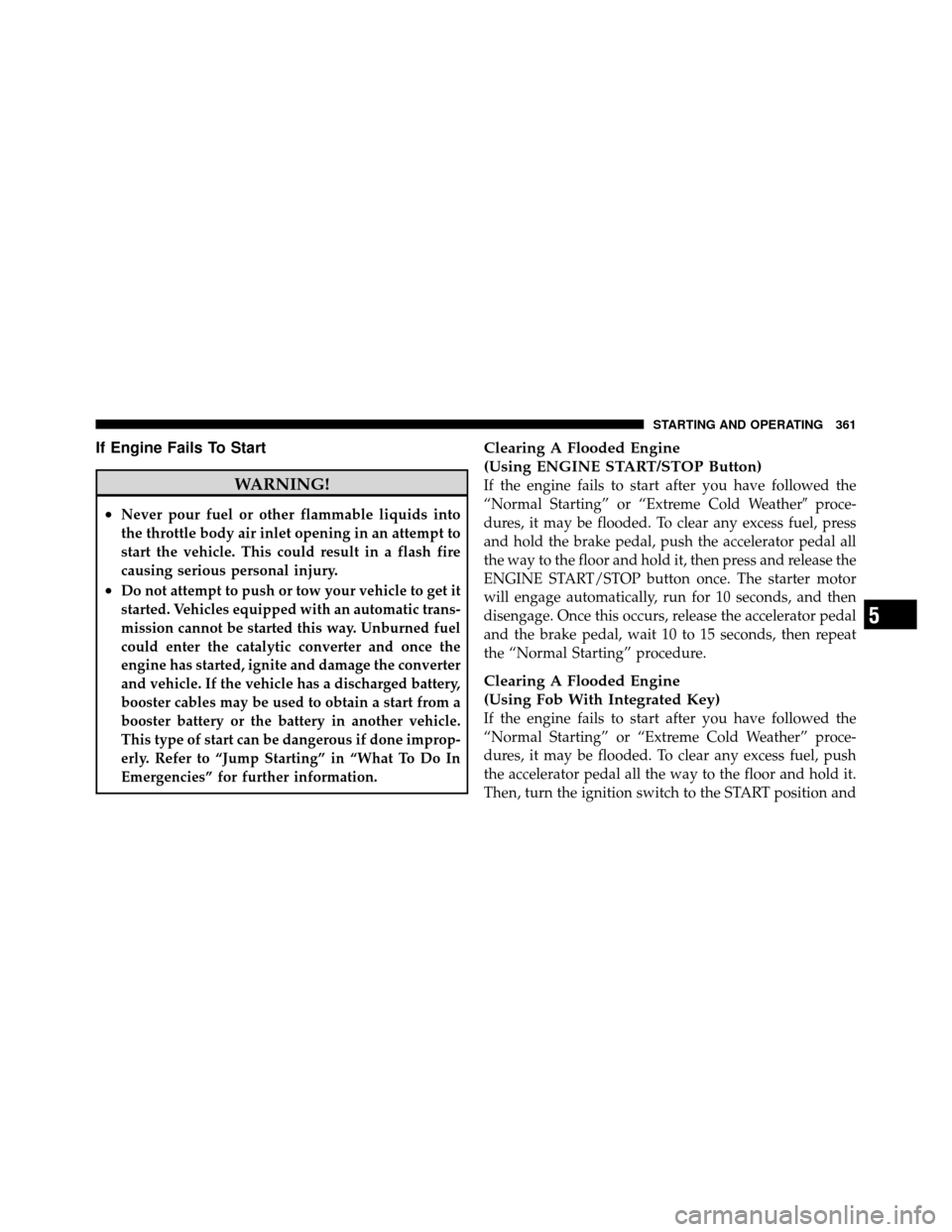Page 283 of 573

Vehicles Not Equipped With Keyless Enter-N-Go
1. Turn the ignition switch to the ON/RUN position (Do
not start the engine.)
2. Fully depress the accelerator pedal, slowly, three times
within 10 seconds.
3. Turn the ignition switch to the OFF/LOCK position.
NOTE:If the indicator message illuminates when you
start the engine, the oil change indicator system did not
reset. If necessary, repeat these steps.
Fuel Economy
Press and release the UP or DOWN button until “Fuel
Economy” displays highlighted in the EVIC and press
the SELECT button. The following Fuel Economy func-
tions display in the EVIC:
•Average Fuel Economy
•Distance To Empty (DTE)
•Miles Per Gallon (MPG)
Average Fuel Economy
Shows the average fuel economy since the last reset. The
Average Fuel Economy can be reset by following the
prompt in the EVIC to use the SELECT button. When the
fuel economy is reset, the display will read “zero” for two
seconds. Then, the history information will be erased,
and the averaging will continue from the last fuel aver-
age reading before the reset.
Average Fuel Economy Display
280 UNDERSTANDING YOUR INSTRUMENT PANEL
Page 284 of 573

Distance To Empty (DTE)
Shows the estimated distance that can be traveled with
the fuel remaining in the tank. This estimated distance is
determined by a weighted average of the instantaneous
and average fuel economy, according to the current fuel
tank level. DTE cannot be reset through the SELECT
button.
NOTE:Significant changes in driving style or vehicle
loading will greatly affect the actual drivable distance of
the vehicle, regardless of the DTE displayed value.
When the DTE value is less than 30 miles (48 km)
estimated driving distance, the DTE display will change
to a “LOW FUEL” message. This display will continue
until the vehicle runs out of fuel. Adding a significant
amount of fuel to the vehicle will turn off the “LOW
FUEL” message and a new DTE value will display.
Vehicle Speed
Press and release the UP or DOWN button until “Vehicle
Speed” displays highlighted in the EVIC and press the
SELECT button. Press the SELECT button to display the
current speed in mph or km/h. Pressing the SELECT
button a second time will toggle the unit of measure
between mph or km/h.
NOTE:
Changing the unit of measure in the Vehicle Speed
menu will not change the unit of measure in the EVIC.
Trip Info
Press and release the UP or DOWN button until “Trip
Info” is highlighted in the EVIC and press the SELECT
button. Press and release the UP/DOWN buttons to
highlight one of the following functions if you want to
reset it:
Trip A
Shows the total distance traveled for Trip A since the last
reset.
4
UNDERSTANDING YOUR INSTRUMENT PANEL 281
Page 333 of 573

cold or snowy conditions that require extra heat at the
windshield. This setting is good for maintaining comfort,
while reducing moisture on the windshield.
5. Front Defrost ModeAir is directed through the windshield and side
window demist outlets. Use DEFROST mode with
maximum blower and temperature settings for best
windshield and side window defrosting.
NOTE: The air conditioning compressor operates in
MIX and DEFROST, or a blend of these modes even if the
A/C button is not pressed. This dehumidifies the air to
help dry the windshield. To improve fuel economy, use
these modes only when necessary.
6. Electronic Rear Window Defrost Press this button to turn on the rear window
defroster and the heated outside mirrors (if
equipped). An indicator in the button will illuminate
when the rear window defroster is on. The rear window defroster automatically turns off after approximately
10 minutes. For an additional five minutes of operation,
press the button a second time.
NOTE:
•You can turn off the heated mirror feature at anytime
by pressing the rear window defroster switch a second
time.
•To prevent excessive battery drain, use the rear win-
dow defroster only when the engine is operating.
CAUTION!
Failure to follow these cautions can cause damage to
the heating elements:
(Continued)
330 UNDERSTANDING YOUR INSTRUMENT PANEL
Page 338 of 573

7. Front Defrost ModeAir is directed through the windshield and side
window demist outlets. Use DEFROST mode with
maximum blower and temperature settings for best
windshield and side window defrosting.
NOTE: The air conditioning compressor operates in
MIX and DEFROST, or a blend of these modes even if the
A/C button is not pressed. This dehumidifies the air to
help dry the windshield. To improve fuel economy, use
these modes only when necessary.
8. Electronic Rear Window Defrost Press this button to turn on the rear window
defroster and the heated outside mirrors (if
equipped). An indicator in the button will illuminate
when the rear window defroster is on. The rear window
defroster automatically turns off after approximately
10 minutes. For an additional five minutes of operation,
press the button a second time. NOTE:
•You can turn off the heated mirror feature at anytime
by pressing the rear window defroster switch a second
time.
•To prevent excessive battery drain, use the rear win-
dow defroster only when the engine is operating.
CAUTION!
Failure to follow these cautions can cause damage to
the heating elements:
•Use care when washing the inside of the rear
window. Do not use abrasive window cleaners on
the interior surface of the window. Use a soft cloth
and a mild washing solution, wiping parallel to
the heating elements. Labels can be peeled off
after soaking with warm water.
(Continued)
4
UNDERSTANDING YOUR INSTRUMENT PANEL 335
Page 356 of 573
STARTING AND OPERATING
CONTENTS
�Starting Procedures .................... 357
▫ Automatic Transmission ............... 357
▫ Keyless Enter-N-Go – If Equipped ........ 358
▫ Normal Starting ..................... 359
▫ Extreme Cold Weather (Below –20°F Or
�29°C) ............................ 360
▫ If Engine Fails To Start ................ 361
▫ After Starting ....................... 362
� Engine Block Heater — If Equipped ........ 362�
Automatic Transmission ................. 363
▫ Key Ignition Park Interlock ............. 363
▫ Brake/Transmission Shift Interlock System . . 364
▫ Fuel Economy (Econ) Mode ............. 364
▫ Six-Speed Automatic Transmission ........ 365
▫ Gear Ranges ........................ 366
� Driving On Slippery Surfaces ............. 371
▫ Acceleration ........................ 371
▫ Traction ........................... 371
5
Page 358 of 573

▫Full Size Spare – If Equipped ............ 400
▫ Limited-Use Spare – If Equipped ......... 400
▫ Tire Spinning ....................... 401
▫ Tread Wear Indicators ................. 402
▫ Life Of Tire ........................ 402
▫ Replacement Tires .................... 403
� Tire Chains .......................... 404
� Snow Tires .......................... 406
� Tire Rotation Recommendations ........... 406
� Tire Pressure Monitor System (TPMS) ....... 407
▫ Base System ........................ 410
▫ Premium System – If Equipped .......... 412�
Fuel Requirements ..................... 417
▫ 3.6L Engine ........................ 417
▫ Reformulated Gasoline ................ 417
▫ Gasoline/Oxygenate Blends ............. 418
▫ E-85 Usage In Non-Flex Fuel Vehicles ...... 418
▫ MMT In Gasoline .................... 419
▫ Materials Added To Fuel ............... 419
▫ Fuel System Cautions ................. 420
▫ Carbon Monoxide Warnings ............ 421
� Flexible Fuel — If Equipped .............. 421
▫ E-85 General Information ............... 421
▫ Ethanol Fuel (E-85) ................... 423
▫ Fuel Requirements ................... 423
5
STARTING AND OPERATING 355
Page 359 of 573
▫Selection Of Engine Oil For Flexible Fuel
Vehicles (E-85) And Gasoline Vehicles ...... 424
▫ Starting ........................... 424
▫ Cruising Range ...................... 424
▫ Replacement Parts ................... 425
▫ Maintenance ........................ 425
� Adding Fuel ......................... 425
▫ Fuel Filler Cap (Gas Cap) .............. 425 ▫
Loose Fuel Filler Cap Message ........... 427
� Vehicle Loading ...................... 427
▫ Vehicle Certification Label .............. 427
� Trailer Towing ........................ 430
▫ Common Towing Definitions ............ 430
▫ Towing Tips ........................ 442
� Recreational Towing
(Behind Motorhome, Etc.) ................ 443
356 STARTING AND OPERATING
Page 364 of 573

If Engine Fails To Start
WARNING!
•Never pour fuel or other flammable liquids into
the throttle body air inlet opening in an attempt to
start the vehicle. This could result in a flash fire
causing serious personal injury.
•Do not attempt to push or tow your vehicle to get it
started. Vehicles equipped with an automatic trans-
mission cannot be started this way. Unburned fuel
could enter the catalytic converter and once the
engine has started, ignite and damage the converter
and vehicle. If the vehicle has a discharged battery,
booster cables may be used to obtain a start from a
booster battery or the battery in another vehicle.
This type of start can be dangerous if done improp-
erly. Refer to “Jump Starting” in “What To Do In
Emergencies” for further information.
Clearing A Flooded Engine
(Using ENGINE START/STOP Button)
If the engine fails to start after you have followed the
“Normal Starting” or “Extreme Cold Weather�proce-
dures, it may be flooded. To clear any excess fuel, press
and hold the brake pedal, push the accelerator pedal all
the way to the floor and hold it, then press and release the
ENGINE START/STOP button once. The starter motor
will engage automatically, run for 10 seconds, and then
disengage. Once this occurs, release the accelerator pedal
and the brake pedal, wait 10 to 15 seconds, then repeat
the “Normal Starting” procedure.
Clearing A Flooded Engine
(Using Fob With Integrated Key)
If the engine fails to start after you have followed the
“Normal Starting” or “Extreme Cold Weather” proce-
dures, it may be flooded. To clear any excess fuel, push
the accelerator pedal all the way to the floor and hold it.
Then, turn the ignition switch to the START position and
5
STARTING AND OPERATING 361